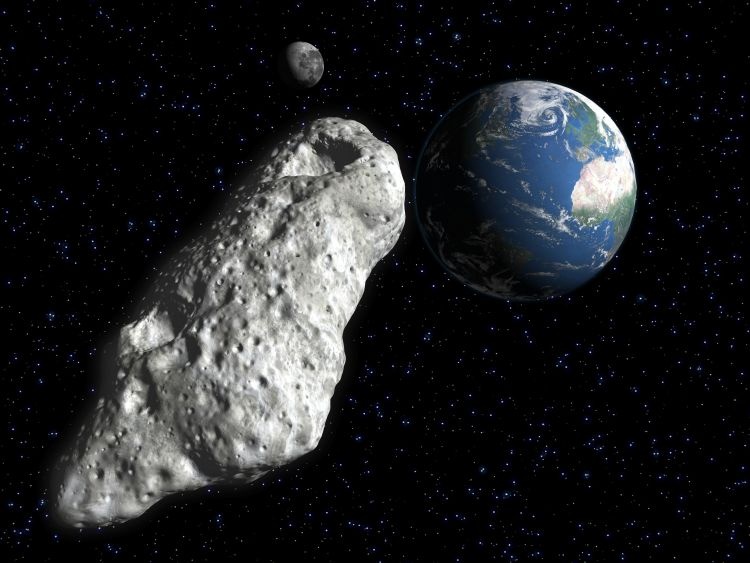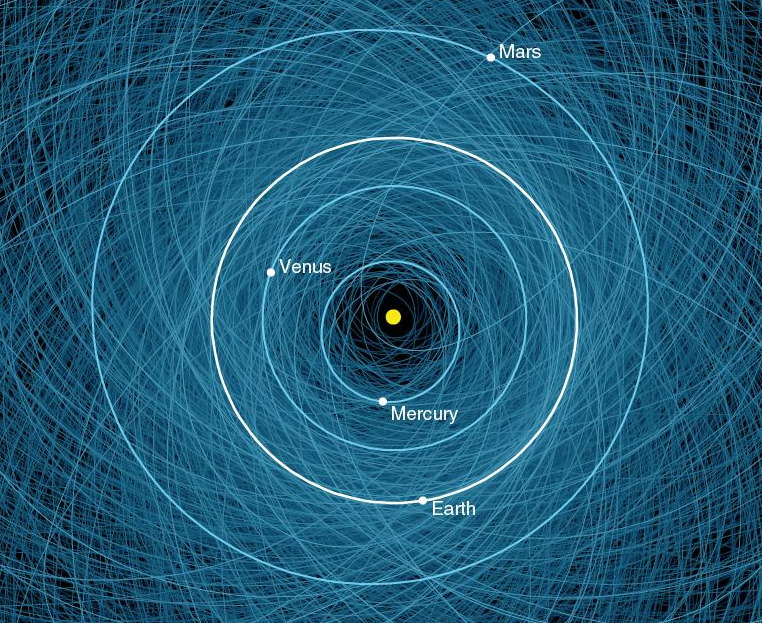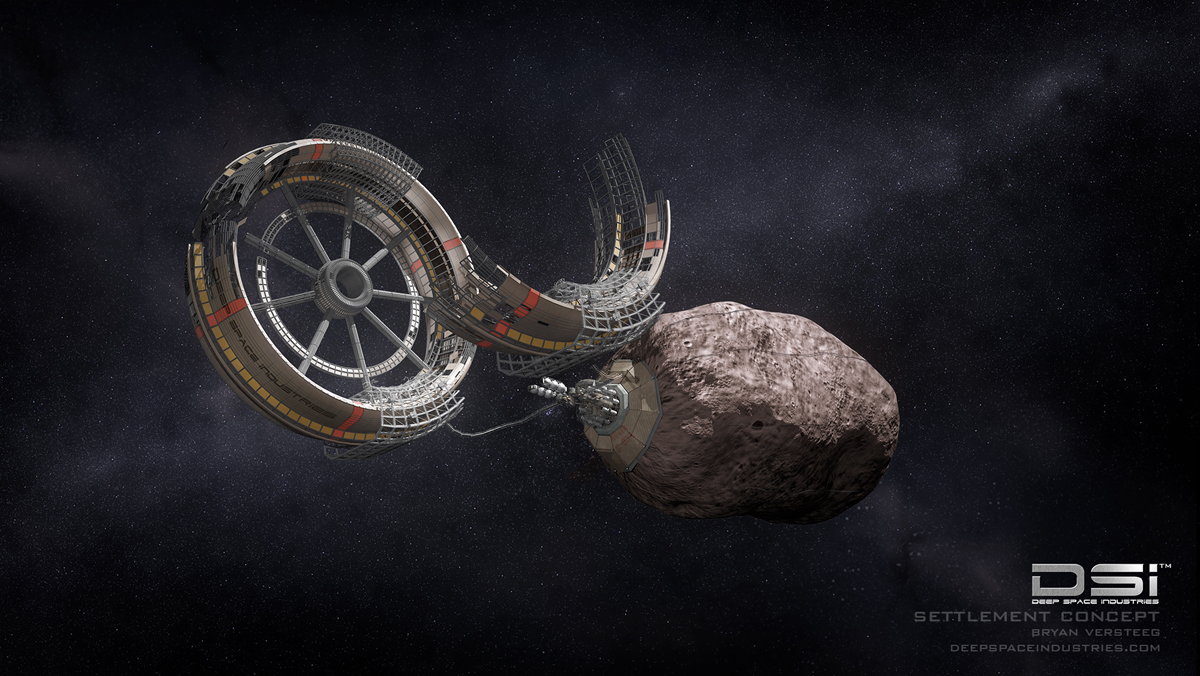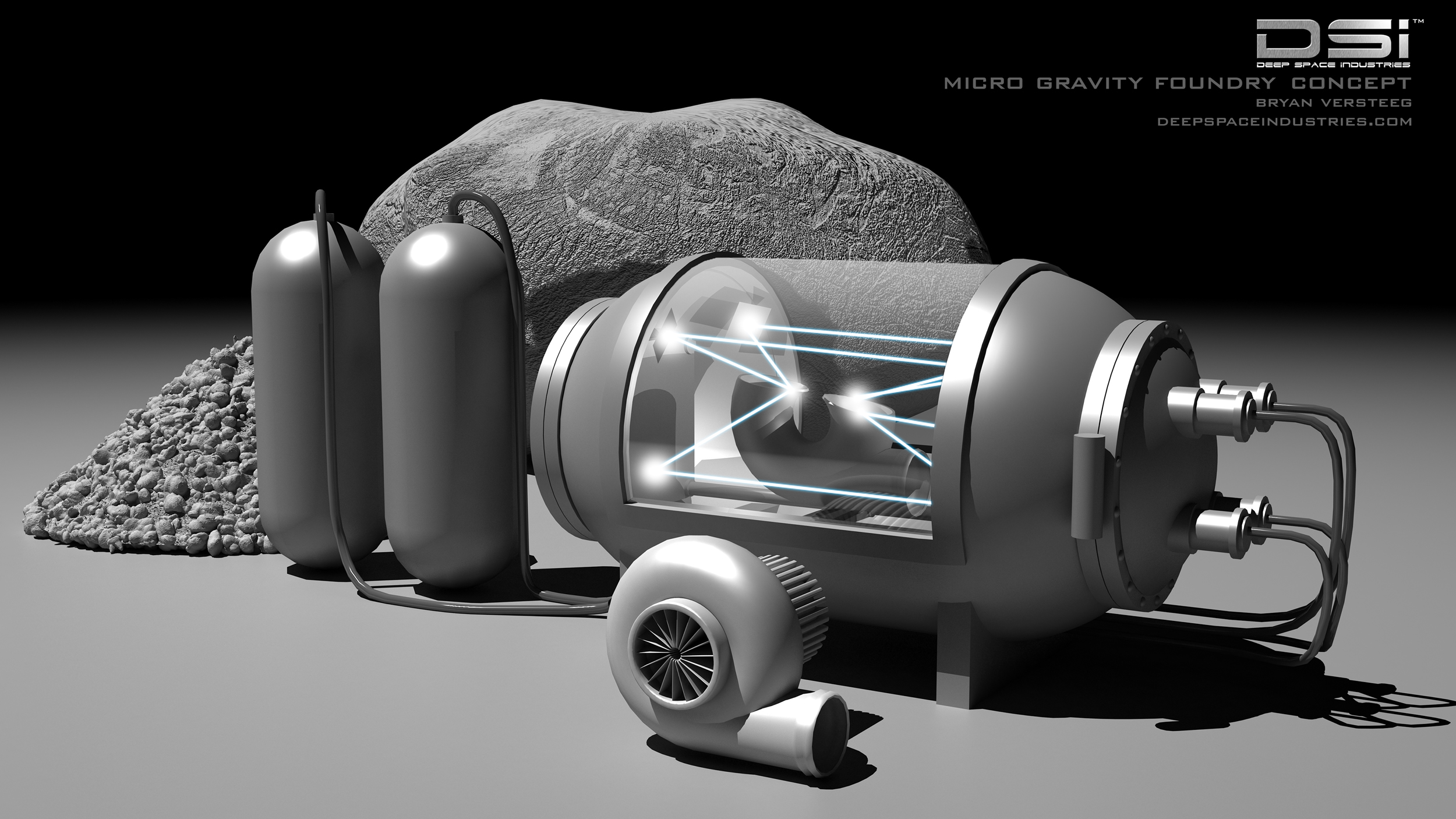
Mining The Asteroids: Who Decides?

This article was originally published on Raw Science. The publication contributed this article to Live Science's Expert Voices: Op-Ed & Insights.
Our civilization—and presumably any civilization with a technological capacity at least as advanced as ours—runs on energy and raw materials. The energy can be drawn from any number of sources: nuclear fusion within stars; nuclear fission in entities similar to our nuclear-power plants; chemical reactions, which on Earth typically involve combining oxygen molecules in the air with carbon-based molecules stored over long eras in deposits of coal, oil, or natural gas; motions of fresh-water streams, atmospheric gases, and ocean waves and currents, which arise from the energy input from a nearby star; tidal movements of the oceans, the result of gravitational forces from the sun and moon; and the internal heat within a planet, the result of the decay of radioactive minerals beneath the surface. Our society exploits all of these energy sources (though the last two of them, tidal motions and geothermal energy, barely rank as significant contributors to the total) with varying degrees of efficiency and environmental impact.
For raw materials, humans have dug into our planet’s surface to mine familiar elements such as iron, copper, nickel, zinc, tin, cobalt, platinum, tungsten, manganese, antimony, molybdenum, titanium, lead, silver, and gold, plus a host of much scarcer “rare-earth elements” that include scandium, yttrium, gadolinium, praseodymium, hafnium, holmium, promethium, and cerium, which are now essential for advanced magnetic and electronic devices. Extracting these elements—along with the carbon-based fuels listed above—has a long, complex, and often sordid history, for the simple reason that these resources have seemed essential to political and cultural groups that strive to assure that they can obtain what they need (as they see things) for their survival. Today, for example, the fact that most of the rare-earth elements are found in northwestern China bulks large in strategic planning for our unknown future. [Asteroid Mining No Crazier Than Deep-Sea Drilling, Advocates Say ]
How, then, should we regard the fact that as we exhaust the most reachable and extractable elemental deposits on Earth, our neighborhood within the solar system contains thousands of sizable asteroids, which range from a few hundred kilometers across, for the largest few, down to a few hundred meters for the smallest that we shall consider? Most of these asteroids circle the sun between the orbits of Mars and Jupiter, but a significant fraction have orbits that carry them close to Earth. In theory, and in practice as well within the next few decades, we can send spacecraft capable not only of landing on these asteroids but also of conducting automated mining operations upon them. Because the asteroids’ low surface gravity strongly reduces the energy requirements for sending asteroidal ore back to our planet, mining the asteroids could compete economically, before too many decades have passed, with mining operations on Earth, the more so as we continue to exhaust our planet’s raw materials.

But what are the asteroids made of? And who should decide what happens to the material within them? The first question has a comparatively easy answer: Since the Earth’s crust formed from countless impacts of asteroid-like objects, the asteroids, with important variations from object to object, almost certainly resemble various regions of our planet’s crust in their elemental composition. From this viewpoint, we are already mining the asteroids—the ones that arrived on Earth four and a half billion years ago. Like the Earth’s surface, some asteroids should prove much richer than others in particular elements that we seek, but as a class they should heartily mimic the Earth’s topmost few kilometers. In dealing with the second question, Who should organize and perform asteroid mining?, we find ourselves deep in the messiness of human society and political organization.
Speaking of organization, any discussion of mining the asteroids should examine humanity’s past attempts to settle the question of who owns them. In 1967, under the aegis of the United Nations, the chief nations of Earth signed the “Outer Space Treaty,” more formally called the Treaty on Principles Governing the Activities of States in the Exploration and Use of Outer Space, including the Moon and Other Celestial Bodies.” The first article of this treaty states that “[t]he exploration and use of outer space, including the Moon and other celestial bodies, shall be carried out for the benefit and in the interests of all countries, irrespective of their degree of economic or scientific development, and shall be the province of all mankind. Outer space, including the Moon and other celestial bodies, shall be free for exploration and use by all States without discrimination of any kind, on a basis of equality and in accordance with international law, and there shall be free access to all areas of celestial bodies. There shall be freedom of scientific investigation in outer space, including the Moon and other celestial bodies, and States shall facilitate and encourage international cooperation in such investigation.” The next article proclaims that “[o]uter space, including the Moon and other celestial bodies, is not subject to national appropriation by claim of sovereignty, by means of use or occupation, or by any other means.” More than 90 countries have now agreed to this treaty.
If words governed the world, these lines would answer the question of who owns the asteroids: we all do. (Clever lawyers would spy an enormous loophole in the treaty’s language: No state can claim sovereignty over a celestial body, but any private citizen or corporation can arguably do so. Thus can lawyers drive their economic camels toward the needle’s eye of any particular legal principle.) In practice, however, the treaty has drawn little attention. [Does Asteroid Mining Violate Space Law? ]
Get the Space.com Newsletter
Breaking space news, the latest updates on rocket launches, skywatching events and more!
In 1967, humans had never visited the moon, and the era of artificial Earth satellites was only a decade old. A few years later, as lunar exploration and exploration lay much closer in the future, the follow-on to the Outer Space Treaty, the “Moon Treaty” (more formally, the “Agreement Governing the Activities of States on the Moon and Other Celestial Bodies”) banned all weapons from the moon and specified that “All activities on the Moon, including its exploration and use, shall be carried out in accordance with international law, in particular the Charter of the United Nations . . .” (The texts of both the Outer Space and Moon treaties are at Attempts to achieve global ratification of this treaty failed dismally. Except for France, all the spacefaring nations of that epoch and its near future withheld their assent; to date, the agreement carries signatures from only 16 countries.
One may judge it no accident that you have probably never heard of the widely agreed-upon Outer Space Treaty or the little-ratified Moon Treaty. Today they seem relics of a past era, more hopeful of international harmony, replaced by a harsher reality in which each nation’s perceived needs dominates over the desire to work together toward a better future. What does this imply for the future of human activities of an asteroidal nature?
Most obviously, the spirit that motivated the Outer Space Treaty has apparently gone with the wind of comparative chaos that has swept through the 21st century. The disappearance of the Soviet Union and the end of the cold war have broken the superpower stalemate, so dangerous and unproductive in some aspects, though usefully conservative in others, that kept both western and Soviet countries from rushing to exploit the available resources of nearby celestial objects. In addition, of course, the lack of appropriate technology played a crucial role. It is worth nothing, though, that for more than thirty years we have known how to start mining the moon, but have not done so.

Today the world works differently (when it works at all): No balance of powers will prevent mining operations in space; instead, a race of exploitation seems likely to erupt at least as soon as the first actual attempts to extract ores from the moon or the asteroids come close to reality. We can anticipate many conflicts in these efforts, which lurk, for instance, in proposed legislation introduced in the U. S. House of Representatives in July 2014, which states that “[a]ny resources obtained in outer space from an asteroid are the property of the entity that obtained such resources.”
How might we feel about the possibility of this race toward riches in space? And what do our feelings matter to whatever process may govern this race? As those who have read this far may have rightly concluded, I am against the mining of ore from the moon or the asteroids, for the same reason that I am against exploiting Earth’s natural resources without regard to where they may be located. Here on Earth we continue to struggle to find a balance between preserving our environment—or at least mitigating the negative effects of our extraction efforts—and supplying what society needs to continue along its current path. (The debate over how, why, and when to change that path can provide the raw material for another essay.) Only when we manage to find a way to keep our own planet in balance should we begin to extract what we need from our neighbors. To me, this approach has both a practical and a moral side, as it directs our attention to our home planet and to what we are doing to it and why, and also raises a deep question (at least for those who see the answer as debatable): Are we entitled to do what we like with other celestial bodies, because (presumably) they contain or maintain no life or any other reason to restrain ourselves in exploiting what they offer our species?
To cite a relevant example from the latter category, consider the fact that the surface of solar-system objects lacking an atmosphere, such as those of the moon or the asteroids, hold the oldest records of the formation process that made the sun and everything that orbits around it. Discovering the details of that process would increase our overall understanding of how the planets, moons, asteroids, and meteoroids achieved their present forms, which in turn might provide important clues to the inner structure of our own planet. Scientists continue to debate whether vast deposits of hydrocarbons lie dozens of kilometers below the Earth’s surface, either trapped from non-biologically-sourced interplanetary material during the final stages of the Earth’s formation, or composed of biologically-made compounds that migrated through cracks into underground reservoirs. Twenty-five years ago, deep-drilling efforts to resolve such questions had modest support but failed to justify their expense.
Furthermore, although it seems likely that neither the moon nor the asteroids ever had living organisms on their surfaces, we should not prejudge this issue. Life on Earth has proven immensely hardy, capable of surviving in tremendous quantities beneath many kilometers of rock, or in suspended animation over long periods of time. Any discovery of extraterrestrial life—or of its fossil remnants—would, of course, offer immense benefit in our attempts to discern how life begins and evolves, starting with the basic question of whether any such life shares our own DNA-based reproduction method (which would support the theory of “panspermia,” the migration of life from world to world) or demonstrate that varied pathways can take raw material from nonlife to life. This call to caution goes double, or quadruple, when applied to objects such as Venus, Mars, or the giant planets and their satellites, where conditions appear far more favorable to life than the dry and airless surfaces of the smaller objects close to us. The possibility that the first human explorers on Mars could accidentally spread Earthly microorganisms, forever depriving us of the chance to be certain as to whether life found on Mars was original or imported, sends chills down the spines of scientists who dream of uncovering the facts about life’s distribution within the solar system.

If you find yourself unmoved by these somewhat arcane arguments, which rest at least partially on a moral principle of non-interference with the multi-billion-year history recorded within cosmically nearby objects, consider this: When you use it up, it’s gone. Applied to Earth, this truism drives the desire to mine the moon and asteroids, but it obviously applies to worlds beyond as well. If we take a long view of human existence, hoping that our society or something like it can survive for many thousands of years, we must recognize that all the asteroids, from thousand-kilometer-wide Ceres down to the thousands of them with diameters of a few hundred meters, have a combined mass less than one one-thousandth of the Earth’s. To be sure, the asteroids’ small sizes make their contents far more accessible than the Earth’s deep interior, but this advantage must be contrasted with the distances to the asteroids and the difficulties of operating in the vacuum of space. Not to mention—all right, let us mention it—the difficulty and expense of either of transporting the material mined from an asteroid many million kilometers from Earth, or, in an alternate scenario, that associated with moving an entire asteroid into our immediate vicinity. An enthusiast might well assert that we must adopt a double-bladed approach: to mine the asteroids even as we develop new techniques to rake the seabeds and drive deeper into our planet.
I stand with those who seek to help humanity survive for the long term by curbing our innate tendency, honed through long experience and evolution on Earth, to take what we can, when we can, on the seemingly reasonable principle that we may not have another opportunity to do so. We now all recognize that this approach brings serious trouble as we fill up the planet and use its readily accessible nonrenewable resources. We split, in broad outline, between those who see these facts as calling for more opportunities to follow our historical pattern, and those who hope that we can adjust, as we have before, to changed circumstances. We no longer (for the most part) regard as enemies those whose beliefs differ from ours; we see the advantages of willing cooperation among sovereign states; and we are beginning to recognize how global intercommunication will change our worldview and economic activities. Some day we will accept the fact that our ever-increasing technological abilities imply that automated spacecraft must prove ever more superior to human travelers through space, despite our innate belief that without a human presence, we are “not really there” on our journeys of exploration.
All this lies in the future—no one knows how far, but probably sufficiently close in time that young generations now on Earth will live to see a stream of travel (robotic at least) within our planetary system. The present situation, in which billions of dollars must be invested to pluck a few hundred grams of matter from the most accessible asteroids and return this precious cargo to Earth, will yield to a new reality in which we can send our equipment throughout the inner solar system. Will our decisions in this area be based solely on issues of profit and loss, or will we develop the insight to see how small a part of our long-term future resides in these “considerations”—a word whose roots translate as “with the stars”?
Join our Space Forums to keep talking space on the latest missions, night sky and more! And if you have a news tip, correction or comment, let us know at: community@space.com.










